Search Results for 'jessica higgins' ↓
September 19th, 2007
LIVE FROM CAMOUFLASH: Artist Organized Art will be reporting from Poland at Camouflash,
an international artists meeting event and exhibition to be held at the
Patio Art Center, of The Academy of Humanities and Economics, in Łódź, Poland.
The show will take place 12-27 October 2007, opening on friday, 12 October.
Stay posted for coverage, documentation, commentary, interviews and more.
International Artists Meeting
12 – 27 października 2007
curator: Mariusz Sołtysik
rationale: The contemporary culture is rather pictorial in nature, idea has been marginalised. The plethora of pictures in our lives induces a sense of being lost, or immunises us against them by creating and augmenting trite reception of such pictures, which, consequently, makes them neutral (e.g. another murder). Obviously, such trite and superficial reception is also true of religion, art and its products. On the other hand, noticeable social behaviours indicate an urge to appear in the media in a short flash of an advertisement or reality show. This urge replaces the essential question: “what idea do I want to pass across?” or “what is my principal message?” People appear to participate in the social and cultural life, but on the level of entertainment, rather than inclusion or reflection on human existence. The present-day society seems to be complex, however, following the thought of Jean Baudrillard, it is rather a mass that is “an opaque nebula whose growing density absorbs all the surrounding energy (…), to collapse finally under its own weight. A black hole which engulfs the social.” Before the black whole is formed, however, there is a short, yet spectacular explosion, followed by a collapse of a massive star. Relating this to human behaviours, perhaps this flash is the one and only opportunity to step out of obscurity before disappearing and being absorbed by the mass? To what extent, then, is this flash true and is not a camouflage, a desire to be somebody else for a moment? It seems that just to induce the question “who am I and what am I doing?” is in itself a great success. Mariusz Soltysik The Camouflash
artists:
Janusz Baldyga – Poland; Olga Bergman – Iceland; Charlie Citron – Nederland;
Martina Galvin – Ireland; Kristaps Gulbis – Latvia; Shilpa Gupta – India;
Jessica Higgins – USA; Gabriele Horndasch – Germany; Ahn Hyun-Ju – Germany;
Eric Van Hove – Belgium; Adam Klimczak – Poland; Erika Knerr – USA;
Anna MacLeod – Ireland; Christine Mackey – Ireland; Tomasz Matuszak – Poland;
Aisling O’Beirn – Northern Ireland; Mariusz “Benek” Olszewski – Poland;
Mariusz Sołtysik – Poland; Ewa Szczyrek-Potocka – Poland; Suzy Sureck – USA;
Richard Thomas – Australia; Miyuki Yokomizo – Japan and others…
#permalink posted by Erika Knerr: 9/19/07 10:02:00 PMAugust 23rd, 2007
Lincoln Center Out Of Doors
Elaine Summers
The Hidden Forest
August 23 ‘07, New York City
Choreographer: Elaine Summers
Dancers: Dale Andree, Joshua Bisset, Harriet Bograd, Meg Chang, Jessica Higgins, Kiori Kawai, Thomas Kortvelyessy, Laura Quattrocchi
Composers/Musicians: Pauline Oliveros, Jay Clayton, Thomas Houser, Carman Moore, Ann Hurley, Lotte Arnsbjerg
Artists: Alison Knowles, Davidson Gigliotti, Murphy Gigliotti, Taketo Shimada, Laura Quattrocchi, Miana Grafals
Assistant Choreographer: Rebecca Loukes
Budget/ Accounting: Debbie Goldberg
Production Designer: Murphy Gigliotti
Organizational Consultant to Miss Summers: Meg Chang
Communications: Jonathan Gill, Cody Hughs
The influential intermedia artist Elaine Summers performed her new work “Hidden Forest” at Lincoln center on August 23rd during twilight. I was one of the eight diverse dancers to participate in the alcove of trees and inside Elaine’s images of dancers floating among the leaves and weather balloons.
During the previous months Elaine began the process in her loft with balls of many shapes, sizes, textures and colors. I often felt that her in depth anatomical and healer’s knowledge could scale to a planetary dimension. She would work with a dancer’s injuries and then spark their kinesthetic imagination. Elaine innovated much of her vision within the framework of the unique qualities that each dancer had. She spoke many times of Dante, of a hidden forest, which inspired her work:
“Midway in the journey of this life
I came upon a dark forest,
Where the path was lost.”
As time rolled by she mesmerized us as only Elaine Summer’s can as we watched her visions of forest and creatures from our context. We were visible and invisible, darting and spinning, and images or sparkles seemed to flash by.

Dale Andree missing – apologies, we wish we could find her pic.
She is a wonderful dancer.
#permalink posted by Jessica Higgins: 8/23/07 08:22:00 PMJuly 12th, 2007
[youtube=http://www.youtube.com/watch?v=k4iH_lZV4Vs][youtube=http://www.youtube.com/watch?v=LRAjNEBF0Ic]
Subject: my James Fuentes story from last night
On Thu, July 12, 2007 2:55 am, JS wrote:
> Erika,
>
> Re: our convo last night about why James is interesting as an organizer
> because of the unusually open channel? I’m sending it to you here for the record.
>
> It was Emily who introduced me to James, I think it was at Bill Stones’
> show at Emily Harvey Gallery, the one with the head maze, such a great
> interactive work. No overkill making the whole body go through tight
> walls. Remember at Emily Harvey Gallery the drop ceiling over the office
> with a height of about 6 feet. Bill adapted it with a walk-in maze hanging
> from the ceiling that came down to about 5+ feet so you experienced the
> confinement from the neck up. It gave the entire opening, which was packed
> solid, a really crazy feel. In the midst of that opening Emily
> brought 20 something James over to meet me with an energy like, Josh, you’re cool, do
> something with James, I have collectors to entertain. I can’t remember
> what was up with Lance Fung Gallery at the time, I think this happened
> after “Five” so we were all in force. But, you know I had had that
> Personal Effects show with Emily and it had caused quite a lot to happen
> to me as an artist, I won’t go into the details – but Emily and I had a
> very good rapport about organization and energy.
>
> James had that Proustian quality of appearing as a small irregularity
> which promised to develop into a massive presence, my antennae were up. I
> found out that James had grabbed a store front on Broome Street and was
> doing a temporary gallery in the space. He was looking for artists. I was
> a bit puffed up at the time and I think I had a handful of shows that year
> already so I wasn’t really in the vein.
>
> A guy named Stephen was my business manager at the time. I met him at his
> office to go over careerist issues, he was quitting smoking. On his office
> wall were three really stunning graphic prints. When I asked Stephen about
> them he told me he had made them and thought they looked nice and put them
> up on the wall to decorate his space. He had no sense of himself as a
> visual artist, whatsoever. I asked how he made the work and he said, “oh,
> they are the filters from my air purifier, I’m such a heavy smoker and I
> have to keep the air clean for everyone else in the office, so I change
> them and they come out like this, they are beautiful.” “Stephen, you
> should consider showing these, you are making a work.” I said. He loved
> the idea, but was clueless. So I told him I was going to get him a show.
>
> I met with James at the desk in the back room of his temporary gallery on
> Broome Street and proposed putting Stephen up. I disclosed to James that
> Stephen was not a declared artist, just someone making these things for
> himself, that they were the filters from an air purifier, that Stephen was
> making them by smoking cigarettes and that James could activate this
> person with a show. James looked at documentation of the work (i had
> Stephen make slides of three pieces he had on his office wall) smiled and
> agreed and gave me a date for Stephen to have a show at James Fuentes
> Gallery.
>
> When I returned to Stephen I explained that there was the problem of
> installation and framing and that he should quickly produce enough of the
> pieces to adequately fill the space, which was not enormous, but required
> maybe 15 good works. Stephen says the problem is that each filter
> requires two months of chain smoking and the three on the wall are the
> only ones he has. Stephen proposes that he buy 15 air purifiers and smoke
> for another two months, but I explain he only has three weeks until the
> opening. For this reason I suggest that he contact the manufacturer of the
> air purifier to negotiate for the discarded test filters. For Stephen, who
> negotiates deals all day, its a natural – a week later he has a pile of
> these things and is simply holding them up one by one and selecting the
> ones he likes.
>
> Stephen went on to show with James and I believe, because James opened the
> venue to him, Stephen (who I’m out of touch with for years) showed with
> several other venues. I have one of Stephen’s pieces from James’ Broome
> Street gallery exhibition which I keep up to this day.
>
> J.
Emily Harvey Gallery selected exhibitions included:
Alison Knowles, Coco Gordon, Loose Pages, Emily Harvey Gallery(EHG), NYC, Feb 14, 1983
Eric Andersen, Visitors Walk (performance), EHG, NYC, Oct 30, 1983
Peter Van Riper, Portrait Triptychs, EHG, NYC, Nov 30, 1984
Valery Gerlovin, Rimma Gerlovina, N/A, EHG, NYC, Apr 19, 1985
Dorothee Selz, Eat-Art Event, EHG, NYC, Jun 19, 1985
Joel Ducorroy, License Plates Works, EHG, NYC, Oct 18, 1985
Eric Andersen, Please Leave (performance), EHG, NYC, Nov 22, 1985
Charlie Morrow, Citywave Copenhagen in New York, EHG, NYC, Jan 14, 1986
Alison Knowles, Malcolm Goldstein, Breath River Route (performance/installation), EHG, NYC, Mar 22, 1986
Dick Higgins, Arrow Paintings, Emily Harvey Gallery(EHG), NYC, Nov 7, 1986
Martin Richard+Richard Martel+Pieere-Andre Arcand, Performance, EHG, NYC, Nov 14, 1986
Ken Friedman, Fluxus Objects, Fluxus Clothes 1966-1986, EHG, NYC, Jan 8, 1987
Jacques Halbert, Projects for Paintings, EHG, NYC, Apr 24, 1987
Hans Breder, Ursonate 1986, EHG, NYC, May 1, 1987
Group, BY THE LETTER – A show of text in art –, EHG, NYC, May 19, 1987
Brendan Atkinson, Painting Money, EHG, NYC, Sep 25, 1987
Alison Knowles, Finger Book, EHG, NYC, Oct 23, 1987
Citizen Kafka, Citizen Sells Out, EHG, NYC, Nov 14, 1987
Piotr Rypson, Slide lecture on polish Futurism, EHG, NYC, Dec 3, 1987
Eric Andersen, Third Divertisement, EHG, NYC, Dec 5, 1987
Carolee Schneemann, Self Shot: Photographic Sequence & Video Installation, Emily Harvey Gallery(EHG), NYC, Jan 15, 1988
Eric Andersen, To Dick and Achilleus, EHG, NYC, Feb 21, 1988
Group, Extended Play , curated by Ursula Block & Christian Marclay, (Flexidisc Catalogue), EHG, NYC, Feb 12, 1988
Ken Friedman, Made in Finland, EHG, NYC, March 18, 1988
Larry Miller, Earthly Works, Emily Harvey Gallery(EHG), NYC, Apr 15, 1988
Jean Dupuy, WHERE, EHG, NYC, May 17, 1988
Group, A La Lettre , EHG, NYC, Jul 15, 1988
Ben Patterson, Ordinary Life, EHG, NYC, Sep 23, 1988
Eric Andersen, !Lo Lamentamos! !Fuera De Servicio!, EHG, NYC, Oct 21, 1988
Charlie Morrow, Wedding Event , EHG, NYC, Oct 23, 1988
Joel Ducorroy, New Work for New York, EHG, NYC, Oct 28, 1988
Group, Extra! Special Editions, EHG, NYC, Dec 6, 1988
Henry Flynt, Classic Modernism and Authentic Concept Art, EHG, NYC, Jan 27, 1989
Henry Flynt, Publication Party for lo no.14, Emily Harvey Gallery(EHG), NYC, Mar 3, 1989
Henry Flynt, Tape Concert – Hoedown, Glissando #1, EHG, NYC, Mar 9, 1989
Dick Higgins, Maps and More, EHG, NYC, Mar 17, 1989
Ay-o, Corner, Higgins, Knowles – Talk w/ Robert C. Morgan on Fluxus @ soho20 gallery, EHG, NYC, Apr 14, 1989
Yoshi Wada, a Sound Installation, EHG, NYC, Apr 21, 1989
Jean Dupuy, Special edition for Hypermetropes, EHG, NYC, May 16, 1989
Brian Buczak, a Memorial Exhibition, EHG, NYC, Jul 4, 1989
Ben Vautier, Art Does Not Exist, EHG, NYC, Sep 16, 1989
Eric Andersen, Call 212-431-7169, EHG, NYC, Oct 20, 1989
Ben Patterson, What Makes People Laugh, EHG, NYC, Oct 27, 1989
Group, Fluxus & CO, Emily Harvey Gallery(EHG), NYC, Dec 2
Alison Knowles, Seven Indian Moon – (Catalogue) , EHG, NYC, Jan 17, 1990
Charlotte Moorman, Child of the Cello, EHG, NYC, Feb 24, 1990
Christer Hennix, Metaxy: a Wall of Poetry & Fragrance (Perform
ance), EHG, NYC, Mar 18, 1990
Carolee Schneemann, Cycladic Imprints – a Kinetic Installation, EHG, NYC, Mar 23, 1990
Takako Saito, Games, EHG, NYC, Apr 20, 1990
Gerhard Ruhm & Franz Mon, Performance, EHG, NYC, Apr 25, 1990
Dick Higgins, Brown Paintings 1989 – 90, EHG, NYC, Sep 14, 1990
Eric Andersen, The Crying Place (Manhattan), EHG, NYC, Oct 26, 1990
Group, a Fluxus Group Show, EHG, NYC, Dec 14, 1990
Yoshi Wada, A Sound Installation, EHG, NYC, Feb 5, 1991
Henry Flynt, The Samo Graffiti, Emily Harvey Gallery(EHG), NYC, Mar 8, 1991
Albert Fine, 1932 – 1987 (curated by Christian Xatrec), EHG, NYC, Apr 19, 1991
Charlie Doria, an Evening of Poetry & Performance, EHG, NYC, May 31, 1991
Ben Vautier, For a Pluri-Cultural Avant-Garde World – (Catalogue), EHG, NYC, Sep 24, 1991
Ben Vautier, Talk about his statements on ethnies, EHG, NYC, Oct 24, 1991
Giordano Bruno Publish party w/ Dick Higgins, Charlie Doria, EHG, NYC, Oct 29, 1991
Ay-o, Ay-o’s Blackhole, EHG, NYC, Nov 1, 1991
Group, Music for Eye & Ear, EHG, NYC, Dec 4, 1991
Philip Corner, Pieces of Reality, EHG, NYC, Jan 31, 1992
Alison Knowles, Bread & Water, EHG, NYC, Mar 13, 1992
Henning Christiansen, I am a Bird…, EHG, NYC, Apr 24, 1992
Orlan, Lecture, Emily Harvey Gallery(EHG), NYC, Apr 29, 1992
Group, 10 years on Broadway – 1982-1992, EHG, NYC, Sept 18, 1992
Sari Dienes, Rubbing, EHG, NYC, Nov 24, 1992
Henry Flynt, Concept Art, Modern Art and Fantasy, EHG, NYC, Feb 5, 1993
Ay-o, Some Hanging Pieces, EHG, NYC, Mar 19, 1993
Dick Higgins, Natural Histories, EHG, NYC, Apr 23, 1993
Peter Van Riper w/ Setsuko Konishi, Performance, EHG, NYC, May 21, 1993
Alain Arias-Misson, Publish Party, EHG, NYC, Nov 12, 1993
Frances Whitney, Sculpted Light, EHG, NYC, Feb 11, 1994
Joshua Selman, Personal Effects, Emily Harvey Gallery(EHG), NYC, Mar 11, 1994
Kirsten Justesen, Surfacing, EHG, NYC, Apr 22, 1994
Ay-o, Some Hanging Pieces no.10, EHG, NYC, Sep 26, 1996
Ben Patterson, Blame it on Pittsburgh, EHG, NYC, Jan 30, 1997
Emmett Williams, Fresh Impressionism, EHG, NYC, Apr 8, 1997
Alison Knowles, Sea Change, EHG, NYC, Oct 3, 1997
Alain Arias Misson, Shamanix!, EHG, NYC, Apr 9, 1998
Al Hansen, (curated by Gracie Mansion), EHG, NYC, Sep 16, 1998
Al Hansen, Performances (organized by Gracie Mansion), EHG, NYC, Sep 18, 1998
Geoff Hendricks, Sky Notes 1 – 22, EHG, NYC, Jan 29, 1999
Bill Stone, Musings & Ruminations, EHG, NYC, Apr 7, 1999
Jessica Higgins, How it sometimes goes in Kangaroo land, Emily Harvey Gallery (courtesy Lance Fung Gallery,) NYC, Sep 9, 1999
Larry Miller, Genesthetics, EHG, NYC, Oct 8, 1999
Carolee Schneemann, Vespers Pool, EHG, NYC, Jan 27, 2000
Daniel Spoerri, La Cabinet Anatomique – (Catalogue), EHG, NYC, May 11, 2000
Alison Knowles, Footnotes, EHG, NYC, Oct 5, 2000
Alain Arias-Misson, Little Shamani , EHG, NYC, Feb 1, 2001
Christian Xatrec – (Catalogue), EHG, NYC, Apr 12, 2001
Ay-o, Tits Mandala, EHG, NYC, Oct4, 2001
Fluxus Concert (Beginning of Rainbow), EHG, NYC, Nov 3, 2001
Henry Flynt, Musical Recordings Publication Party, EHG, NYC, Nov 4, 2001
Emmett Williams, The Boy & the Bird, screening at Anthology Film Archive, Emily Harvey Gallery(EHG), NYC, Apr 6, 2002
Emmett Williams, Story lines, EHG, NYC, Apr 10, 2002
Berty Skuber, Under Penalty of Law – (Catalogue), EHG, NYC, Oct 3, 2002
Geoff Hendricks, Accidental Significance (Collaboration with Brian Buczak), EHG, NYC, Oct 9, 2003
Jean Dupuy, Looking at Stones – (Catalogue), EHG, NYC, Feb 26, 2004
#permalink posted by Artist Organized Art: 7/12/07 09:39:00 PMApril 19th, 2007
ONLY ONE LARRY MILLER
Only one Miller-Paik. Saturday April 14, 2007. Renowned Fluxus artist Larry Miller pays homage to Nam June Paik with his “variations, adaptations, improvisations, bastardizations” (Miller) of Paik’s performance pieces at the James Cohan Gallery, Chelsea. Paik inspired, the series of performances were indeed one of a kind Miller pieces. And it is through this sort of reliving, reviving, revisiting, resetting Paik that keeps him alive and the only way to truly pay homage to a man who we know as Paik, as Miller would say, with integrity.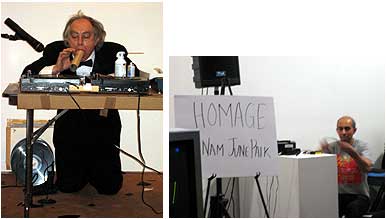 Some people still talk about Paik as the good businessman. One only cares if he is or not, if he is a great artist first. From salesman to artist, Paik’s identity was most confused as he became more of a star commodity. I remember how I would hear that he was aggravated not to yet be collected or showing at MOMA and that somehow that had to do with him being Korean, or at least not white. It must have been interesting to be able to have toggled back and forth between the unfortunate to the very fortunate Asian figure, and what an advantage being able to play such ambiguous roles as, in every sense, from Asian, and not quite so, to artist, con-artist, businessman, performer etc…
Some people still talk about Paik as the good businessman. One only cares if he is or not, if he is a great artist first. From salesman to artist, Paik’s identity was most confused as he became more of a star commodity. I remember how I would hear that he was aggravated not to yet be collected or showing at MOMA and that somehow that had to do with him being Korean, or at least not white. It must have been interesting to be able to have toggled back and forth between the unfortunate to the very fortunate Asian figure, and what an advantage being able to play such ambiguous roles as, in every sense, from Asian, and not quite so, to artist, con-artist, businessman, performer etc…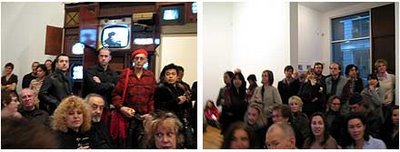 So Paik very frequently introduced Asian or Korean somethingness, Buddha, shaman, traditional percussion, folk etc. Each cultural tandem varies depending on situation and event; what nationality was the TV-Buddha anyway? Then again, what nationality was Paik? But no one can really question his motives since his was marked privilege and this allowed him to create tantalizing and teasing moments of art. And his performances were somehow most effective since the most ambiguous of Paik’s identity was in the performative element of his work. Miller then, realizes that this was somewhat an opportunity. Not just to re-perform Paik’s scores but to play and perform his spirit. Would that not be truly Paik-esque? But also Miller.
So Paik very frequently introduced Asian or Korean somethingness, Buddha, shaman, traditional percussion, folk etc. Each cultural tandem varies depending on situation and event; what nationality was the TV-Buddha anyway? Then again, what nationality was Paik? But no one can really question his motives since his was marked privilege and this allowed him to create tantalizing and teasing moments of art. And his performances were somehow most effective since the most ambiguous of Paik’s identity was in the performative element of his work. Miller then, realizes that this was somewhat an opportunity. Not just to re-perform Paik’s scores but to play and perform his spirit. Would that not be truly Paik-esque? But also Miller.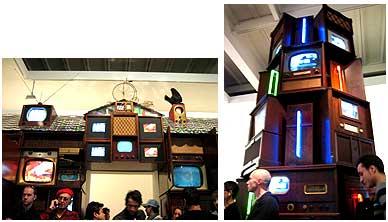 The setting for the evening of performance was perfect. The performance stage was the gallery space between two of Paik’s overarching pieces. As you entered the room, to the left was the In-Flux House (1993) that is like a gatehouse to the other room with Paik’s robot pieces and to the right was the Tower (2001) which was tower made of monitors that had direct live feed of the performance that evening.Appropriately enough, the first piece of the evening was all media. Five televisions and one radio all turned on for media as music, Flux Radio & TV (Realization from “FluxFest Kit 2” published by George Maciunas 1969).*
The setting for the evening of performance was perfect. The performance stage was the gallery space between two of Paik’s overarching pieces. As you entered the room, to the left was the In-Flux House (1993) that is like a gatehouse to the other room with Paik’s robot pieces and to the right was the Tower (2001) which was tower made of monitors that had direct live feed of the performance that evening.Appropriately enough, the first piece of the evening was all media. Five televisions and one radio all turned on for media as music, Flux Radio & TV (Realization from “FluxFest Kit 2” published by George Maciunas 1969).*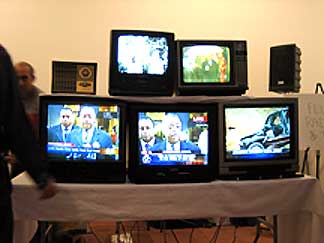 Then Miller starts talking about Paik and Charlotte Moorman, that you cannot have him without her. Miller points out Moorman’s ability to organize large Avant-garde festivals, which she did since 1963, and sometimes working with over 400 artists on them. Miller’s first encounter to the Avant-garde diva Moorman was when she flew by on a helium balloon over Central Park West, followed by many other artists behind her. The Variations on a Theme by Saint-Saens 1964 (Le Cygne, The Swan, excerpt from “Le Carnaval des Animeaux,” based upon performances by Charlotte Moorman, 1933-1991) was performed by pianist Jessica Chen and cellist Lucy Railton. They played classical music until it was time for Railton to get escorted by Miller inside a man-size oil drum full of water. She comes out drenched and still continues to play her cello.
Then Miller starts talking about Paik and Charlotte Moorman, that you cannot have him without her. Miller points out Moorman’s ability to organize large Avant-garde festivals, which she did since 1963, and sometimes working with over 400 artists on them. Miller’s first encounter to the Avant-garde diva Moorman was when she flew by on a helium balloon over Central Park West, followed by many other artists behind her. The Variations on a Theme by Saint-Saens 1964 (Le Cygne, The Swan, excerpt from “Le Carnaval des Animeaux,” based upon performances by Charlotte Moorman, 1933-1991) was performed by pianist Jessica Chen and cellist Lucy Railton. They played classical music until it was time for Railton to get escorted by Miller inside a man-size oil drum full of water. She comes out drenched and still continues to play her cello.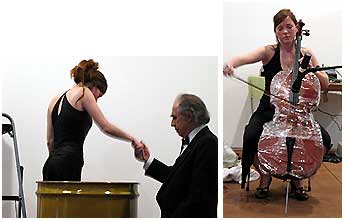 The next piece Zen for Head 1962 (Paik’s interpretation of LaMonte Young’s “Composition 1960 #10, to Bob Morris, Yin Yang Version by Larry Miller 1992) was a beautiful hybrid. From Young’s score of “draw a straight line and follow it” (Miller tells us that evening) to Paik’s variation of just dumping his head in a bucket of ink to draw a Zen line with it (defeating Zen-ness), we see Miller’s two person composition Yin Yang version of Zen for Head. Jessica Higgins and Michael Maxwell simultaneously draws lines with their heads, Higgins in black ink and Maxwell in white, both on canvas, back to back, never before were Zen lines criss-crossed like this.
The next piece Zen for Head 1962 (Paik’s interpretation of LaMonte Young’s “Composition 1960 #10, to Bob Morris, Yin Yang Version by Larry Miller 1992) was a beautiful hybrid. From Young’s score of “draw a straight line and follow it” (Miller tells us that evening) to Paik’s variation of just dumping his head in a bucket of ink to draw a Zen line with it (defeating Zen-ness), we see Miller’s two person composition Yin Yang version of Zen for Head. Jessica Higgins and Michael Maxwell simultaneously draws lines with their heads, Higgins in black ink and Maxwell in white, both on canvas, back to back, never before were Zen lines criss-crossed like this.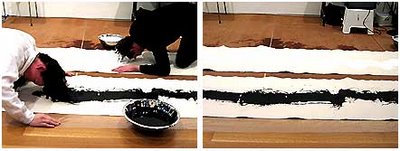 Miller comes out solo with a toy piano. He takes his beret and covers his face, a Miller classic, then starts banging the piano on his head. What was the fixation over head for Paik? Paik must have been laughing as Miller pounds his head with the toy piano over and over again. The audience laughed too at the rather humorous yet disturbing moment. This was a very nice contribution, the 13th Piano Composition for Nam June Paik, this time by Miller.
Miller comes out solo with a toy piano. He takes his beret and covers his face, a Miller classic, then starts banging the piano on his head. What was the fixation over head for Paik? Paik must have been laughing as Miller pounds his head with the toy piano over and over again. The audience laughed too at the rather humorous yet disturbing moment. This was a very nice contribution, the 13th Piano Composition for Nam June Paik, this time by Miller.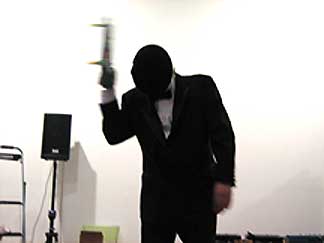 Adaptations from Random Access 1963 was the highlight of the evening. The sine tone tape and consultation was acknowledged to Stephen Vitiello and the instrument construction was done by Miller’s production manager Sean Carrilo, Gillian Wilson, and Miller and performed by Bibbe Hansen, Miller, Maxwell, and Wilson. Hansen DJed a custom designed multi-stack LP player while flaring the needle part like a magic wand creating interruptive sound. Maxwell and Wilson played the strips of audiotapes with the movable sound pick up and Miller destroyed his record player and albums with various things including chewing gum and electric drill. This performance was a mutated, mutilated Random Access which was quite powerful to listen to.
Adaptations from Random Access 1963 was the highlight of the evening. The sine tone tape and consultation was acknowledged to Stephen Vitiello and the instrument construction was done by Miller’s production manager Sean Carrilo, Gillian Wilson, and Miller and performed by Bibbe Hansen, Miller, Maxwell, and Wilson. Hansen DJed a custom designed multi-stack LP player while flaring the needle part like a magic wand creating interruptive sound. Maxwell and Wilson played the strips of audiotapes with the movable sound pick up and Miller destroyed his record player and albums with various things including chewing gum and electric drill. This performance was a mutated, mutilated Random Access which was quite powerful to listen to.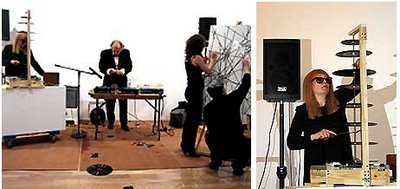 The next piece was Fluxus Champion Contest 1962, an international pissing contest with contestants from England, Scotland, France, US, Poland, Lithuania, France, and Korea. The Scottish winner who pissed the longest (and omni-directionally) won the decorated and signed toilet seat by Miller. At this point, the whole evening was turned up side down. Later, only a couple of us knew that the winner was a (s)he not a ()he, Diane Torr, who had her breasts taped, mustache drawn, and wearing some form of device, who knows what really happened.
The next piece was Fluxus Champion Contest 1962, an international pissing contest with contestants from England, Scotland, France, US, Poland, Lithuania, France, and Korea. The Scottish winner who pissed the longest (and omni-directionally) won the decorated and signed toilet seat by Miller. At this point, the whole evening was turned up side down. Later, only a couple of us knew that the winner was a (s)he not a ()he, Diane Torr, who had her breasts taped, mustache drawn, and wearing some form of device, who knows what really happened.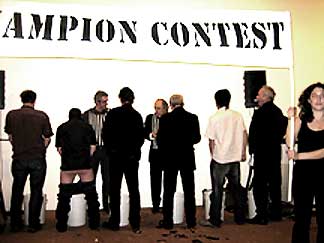 Lastly, on a contemplative note, not one but two Candle TV 1975 were performed. Side by side the two monitors had candlelight burning, softly, in memory of Paik. It was a kind of new stereo-vision of Paik.
Lastly, on a contemplative note, not one but two Candle TV 1975 were performed. Side by side the two monitors had candlelight burning, softly, in memory of Paik. It was a kind of new stereo-vision of Paik.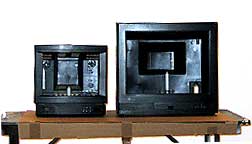 This writing covers the second of two of Larry Miller’s Homage to Nam June Paik events at the James Cohan Gallery. The first evening of performance was on Saturday March 24th which had the classic instrument performances such as 12 Piano Compositions for Nam June Paik by George Maciunas 1962, where rumor has it that Miller did all twelve compositions, which was never done before, as well as performing the famous Paik’s One for Violin Solo 1962. Unfortunately, I was only able to make it to the second evening of which I have the honor to write about. Two Candle TV, two Zen for Head, two nights of evening performance. Two seems like an interesting theme for Only One Larry Miller. It certainly sets a great opposition between the reproduction/binary and original/singularity. On this Miller-Paik occasion, a tie for a tie.
This writing covers the second of two of Larry Miller’s Homage to Nam June Paik events at the James Cohan Gallery. The first evening of performance was on Saturday March 24th which had the classic instrument performances such as 12 Piano Compositions for Nam June Paik by George Maciunas 1962, where rumor has it that Miller did all twelve compositions, which was never done before, as well as performing the famous Paik’s One for Violin Solo 1962. Unfortunately, I was only able to make it to the second evening of which I have the honor to write about. Two Candle TV, two Zen for Head, two nights of evening performance. Two seems like an interesting theme for Only One Larry Miller. It certainly sets a great opposition between the reproduction/binary and original/singularity. On this Miller-Paik occasion, a tie for a tie.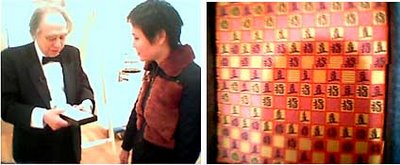 ~Mina CheonAfter the evening an artist organized Candle TV event, Italian restaurant “Pepe Giallo,” Gabriel Kroiz, Mina Cheon and Miller-Paik Candle TV by and with Joshua Selman for Nam June Paik and Larry Miller.
~Mina CheonAfter the evening an artist organized Candle TV event, Italian restaurant “Pepe Giallo,” Gabriel Kroiz, Mina Cheon and Miller-Paik Candle TV by and with Joshua Selman for Nam June Paik and Larry Miller.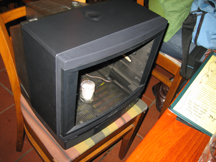
Candle TV Dinner
meal, table, candle light and chairs provided by restaurant
bring Candle TV
place candle inside
share thoughts on Paik during meal
* Titles and descriptions of Nam June Paik performance pieces were originally written in the evening program directed by Larry Miller.
Appropriating from the site: http://www.artnotart.com/fluxus/gmaciunas-12pianocompositi.html
12 PIANO COMPOSITIONS FOR NAM JUNE PAIK, by George Maciunas, Jan. 2, 1962.
Composition no.1 — no.12 & no. 13 by Larry Miller April 14, 2007
1. let piano movers carry piano into the stage
2. tune the piano
3. paint with orange paint patterns over piano
4. with a straight stick the length of a keyboard sound all keys together
5. place a dog or cat (or both) inside the piano and play Chopin
6. stretch 3 higest strings with tuning key until they burst
7. place one piano on top of one another (one can be smaller)
8. place piano upside down and put a vase with flowers over the sound box
9. draw a picture of the piano so that the audience can see the picture
10. write ‘piano composition no.10′ and show to the audience the sign
11. was the piano, wax and polish it well
12. let piano movers carry piano out of the stage
13. Piano for Head (for Nam June Paik) by Larry Miller 2007
#permalink posted by Mina Cheon: 4/19/07 08:42:00 AMApril 15th, 2007
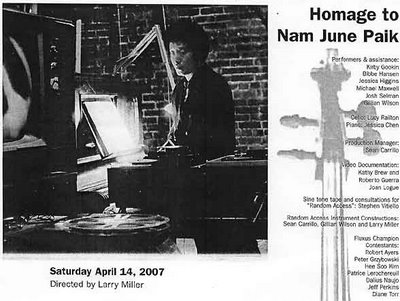 Homage to Nam June Paik
Homage to Nam June PaikSaturday April 14, 2007, Directed by Larry Millier, Performers & assistance: Kirby Gookin, Bibbe Hansen, Jessica Higgins, Michael Maxwell, Josh Selman, Gillian Wilson, Cello: Lucy Railton, Piano: Jessica Chen, Production Manager: Sean Carrillo, Video Documentation: Kathy Brew and Roberto Guerra, Joan Logue, Sine tone tape and consultations for “Random Access”: Stephen Vitiello, Random Access Instrument Constructions for: Sean Carrillo, Gillian Wilson and Larry Miller, Fluxus Champion Contestants: Robert Ayers, Peter Grzybowski, Hee Soo Kim, Patrice Lerochereuil, Dalius Naujo, Jeff Perkins, Diane Torr, Series graphics: Sara Seagull, Special thanks to: Mina Cheon Kroiz and Gabriel Kroiz, Cole Green, Andrew Gurian, Estate of Charlotte Moorman, Sara Seagull, Arthur Solway, Ginger Cofield, Laurie Harrison, James Cohan and the gallery staff
Above photo from FLUXSONATA performed by Nam June Paik, 80 Wooster Street, NYC,
March 17, 1973, Photo by Larry Miller copyright 1973/2007
JAMES COHAN GALLERY
533 West 26th St. NYC
212 714-9500
#permalink posted by Artist Organized Art: 4/15/07 04:42:00 PMMarch 27th, 2007
PURPLE HAZE: The Brooklyn Museum’s opening
of the Elizabeth A. Sackler Center for Feminist Art
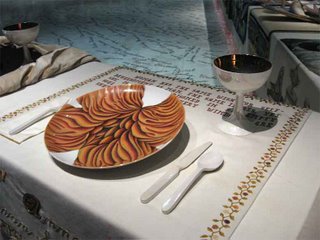 I arrived last Thursday evening at the Brooklyn Museum with Jessica Higgins having certain expectations. On a lead from my editor, I thought that I would encounter the quintessential artist organizer himself, Ryszard Wasko, at the opening of the Elizabeth A. Sackler Center for Feminist Art that night. With the idea of seeing Wasko again at the museum openings, and being asked to cover the event for Artist Organized Art, I also knew I would be seeing Judy Chicago’s iconic, large scale project “The Dinner Party,” for the first time. Although I had read the press release about “Global Feminisms,” co-curated by Maura Reilly, the Sackler Center’s curator, and Linda Nochlin, I still anticipated seeing other seminal works of feminist art from the 1970’s onward and was initially disappointed. My preconceptions of what I would see was confronted with an enormously ambitious, unexpected exhibition in the galleries surrounding “The Dinner Party” that places the work being made by younger women, born since 1960, from 50 countries, together for the viewer to assess the present moment of “Feminism(s).” The experience was one of confusion at first, but in retrospect feels like an appropriate take on the female voice which the Feminist Revolution and it’s early activists began to make audible.
I arrived last Thursday evening at the Brooklyn Museum with Jessica Higgins having certain expectations. On a lead from my editor, I thought that I would encounter the quintessential artist organizer himself, Ryszard Wasko, at the opening of the Elizabeth A. Sackler Center for Feminist Art that night. With the idea of seeing Wasko again at the museum openings, and being asked to cover the event for Artist Organized Art, I also knew I would be seeing Judy Chicago’s iconic, large scale project “The Dinner Party,” for the first time. Although I had read the press release about “Global Feminisms,” co-curated by Maura Reilly, the Sackler Center’s curator, and Linda Nochlin, I still anticipated seeing other seminal works of feminist art from the 1970’s onward and was initially disappointed. My preconceptions of what I would see was confronted with an enormously ambitious, unexpected exhibition in the galleries surrounding “The Dinner Party” that places the work being made by younger women, born since 1960, from 50 countries, together for the viewer to assess the present moment of “Feminism(s).” The experience was one of confusion at first, but in retrospect feels like an appropriate take on the female voice which the Feminist Revolution and it’s early activists began to make audible.
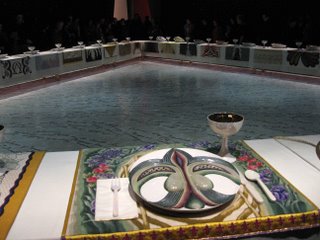 First things first. “The Dinner Party” absolutely surpassed my expectations. I was astonished by it’s beauty, detail and depth. I had seen reproductions, which didn’t come close to the experience of walking intimately, around the triangular, banquet tables, lovingly and ceremoniously set with 39 place settings, tributing historical women from mythical goddesses, to Emily Dickenson. Intricately embroidered table linens sit beneath golden chalices and utensils, around unique, porcelain plates created for each recipient, with radiating forms representing female external sexual organs, not unlike a Georgia O’Keefe, flower painting, who was herself a guest at the table. The lighting is intimate and inviting, with the names of almost 1000 other women written on the tile floor. One of the outlying galleries will rotate an exhibition, relating to the women Chicago highlights in her project.
First things first. “The Dinner Party” absolutely surpassed my expectations. I was astonished by it’s beauty, detail and depth. I had seen reproductions, which didn’t come close to the experience of walking intimately, around the triangular, banquet tables, lovingly and ceremoniously set with 39 place settings, tributing historical women from mythical goddesses, to Emily Dickenson. Intricately embroidered table linens sit beneath golden chalices and utensils, around unique, porcelain plates created for each recipient, with radiating forms representing female external sexual organs, not unlike a Georgia O’Keefe, flower painting, who was herself a guest at the table. The lighting is intimate and inviting, with the names of almost 1000 other women written on the tile floor. One of the outlying galleries will rotate an exhibition, relating to the women Chicago highlights in her project.
Exiting this permanent installation you are once again confronted with the often sensatio
nal images in “Global Feminisms.” There is an over abundance of photography and video, and simplistic, single dimension quick takes, but numerous gems are interspersed as well. A stand out performance work which I believe was “Untitled,” 2006-07, was by the appropriately, one named, Sissi (1977) from Italy. She hovered above the opening crowd, portraying a calm, basic, mindfulness, sitting on a golden branch, in a golden knotted or crocheted body suit like a mythical contemporary goddess of youthful female discernment. I liked Amy Cutler’s “Army of Me,” 2003 (US) and Annika von Hausssolff’s (Sweden), Melanie Manchot’s (Germany), Ingrid Mwangi’s (Kenya), Catherine Opie’s (US), Lisa Reihana’s (New Zealand), Anna Gaskell’s (US) and He Chengyao’s (China) photography. Although I admit to watching very little of the video works, I dug Sonia Khurana’s (India), Salla Tykka’s (Finland) and Boryana Rossa’s (Bulgaria) videos. I always respond to Kara Walker’s (US), Shahzia Sikander’s (Pakistan) and Wangechi Mutu’s (Kenya) paintings. Otherwise lot’s and lot’s of difficult pieces and walk by’s a plenty. It’s an uneven show that for me spoke about the youthfulness of the movement itself. I did find it curious that certain, well known New Yorker’s work, of my generation, like Janine Antoni’s was not present. I did though witness a heart felt conversation she was having with Amy Silman, from afar, like a mini movement of it’s own. Another performative moment in the evening was Martha Wilson and her dance partner tearing up the floor to the music in the Museum’s lobby.
The “F” word and it’s first generation art and heroes of the late sixties and seventies have been by some looked upon as antiquated and taboo in the years of backlash that eventually followed, but we seemed to have come full circle with the present moment to a place that almost feels like it’s infancy again. This show of youthful practitioners leaves room for growth; for me and Jessica and the many other working artists (female and male a like) to fill in the many gaps left here. In that sense it is hopeful. One step backwards, two steps forward…
I loved Roberta Smith’s words in her otherwise scathing NY Times review of the museum’s opening night ensemble: “But feminism is not a style, or a formal approach. It is a philosophy, an attitude and a political instrument. It is more important than Pop, Minimalism or Conceptual art because it is by its very nature bigger than they are, more far-reaching and life-affecting. In addition feminism is not of itself an aesthetic value. It is an idea that can assume an organic force in some artists’ work…”
The cross-cultural worldwide “feminist solidarity/comparative studies model” coined by Chandra Talpade Mohanty, that the exhibition was aimed toward is a good place to examine where we are at. And thinking about solidarity brings me back to Ryszard Wasko. Although I missed him there (as well as Jane Fonda, Elizabeth A. Sackler and Gloria Steinem whom he was probably hanging with in the VIP room), his mentioning that he was attending, led to my spontaneously responding to the new feminist dialogue in the year of celebrating woman artists. So thank you Wasko, Artist’s Organized Art for it’s sudden awakening and woman artists everywhere.
Erika Knerr
#permalink posted by Erika Knerr: 3/27/07 11:43:00 AMFebruary 25th, 2007
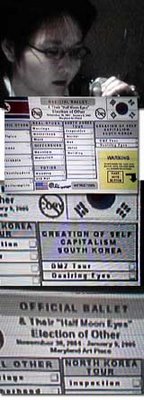
by Jessica HigginsCollege Art Association took place in Manhattan as previously mentioned, I was especially moved by the lectures of
The Woman’s Caucus for Art, titled “The Art Of Being Global: International Art of International Artists.”Mina Cheon, Professor at Maryland Institute College of Art, is an artist working cross-culturally between South Korea, North Korea and the United States. In Dizz/placement: Half Moon Eyes, Mina explores cross cultural inter-perception of female beauty. As self-image fails to be reified into key models(or stereotypes) she uncovers value contradictions between North America, South Korea and North Korea.
In her presentation, Video clips of surgery to the eyes to achieve the half moon effect are projected along with collaged images of cheerleaders and sirens and a touch-screen form of a virtual ballot booth.
“Half Moon Eyes is an interactive media installation that uses touchscreen technology… It displays a web of video clips that deal with… North Korean Women… as either military femme-bot types or mystical goddesses… dolls, sirens and national cheerleaders… beautification and objectification, constructed by and for South Korean media and tourism… a strange cultural othering… triangular relationship between America, South Korea, and North Korea.”
The panel, made entirely of artist/educator/mothers was diverse in it’s forms,
Lisa Kaftori and
Joan Giroux both covered an art of earth and ecology which promotes international community of understanding and an interdisciplinary collabroration in their specific art works. When the panel was finished information, ideas and inspiration swirled in the room, I felt lucky to have attended this diverse and empowering group of woman educators and artists.
#permalink posted by Jessica Higgins: 2/25/07 09:47:00 PM


















